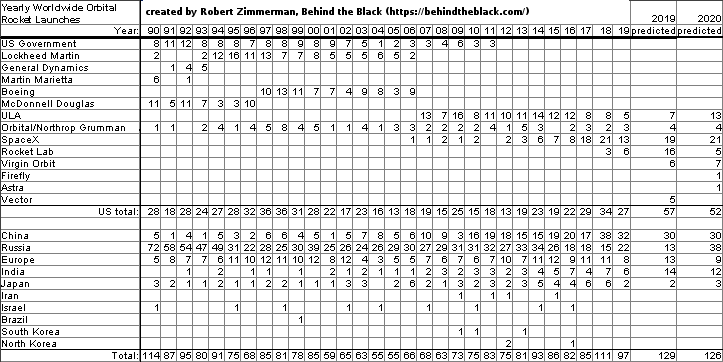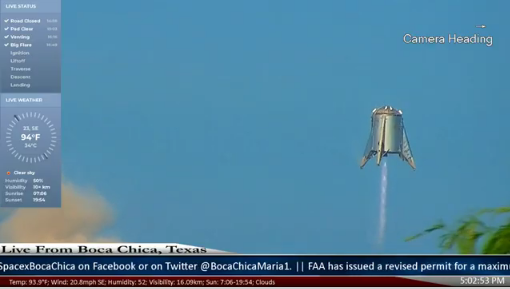The state of the global rocket industry in 2019
With 2019 ending, it is time once again (as I did for 2016, 2017, and 2018) to review the trends in the global launch industry for the past year.
Below is my updated graph, showing the launch numbers for 2019 as well as for every year going back to 1990, just before the fall of the Soviet Union. That range I think covers all recent trends, while also giving some perspective on what happened in 2019.
The graph is worth reviewing at length, as it not only gives a sense of recent trends, it also summarizes well the history of the entire global space industry during the past thirty years. For example, it shows the transition in the U.S. in the past two decades from government-owned launchers to private rockets, a change that has revitalized the American space industry in more ways than can be counted.

First and foremost 2019 showed a decline in total launches from 2018, with global launches dropping from 111 to 97. The 2019 totals were also about 30% below the number of launches predicted by the various countries and launch companies that are now active.
Does this drop in launches mean that the rocket industry is in decline? Not at all. The 97 launches last year were also the most launches in a single year since 1990, when the Soviet Union existed and routinely puffed up the totals each year with many unnecessary launches prompted by their bloated communist bureaucracy. (See last year’s graph for the yearly numbers going back to 1980.)
More important, the numbers this year are based on a much more robust launch industry, made up of many more sound competing constituents, both public and private.
Consider Russia for example. In 2018 that country had its fewest launches, 15, in more than a half century, a decline fueled partly by the loss of its commercial satellite business to SpaceX, and partly because of a major corruption scandal that required them to recall almost every rocket engine and suspend launches for months.
In 2019 however Russia’s launch industry recovered significantly, completing the most launches in four years. Moreover, Roscosmos today predicted that they will complete 40 launches in 2020 (two of which will be launched by Arianespace), the most since the mid-1990s. While there are many reasons to doubt this prediction, it is also likely that they will top their 2019 numbers in 2020, especially because of their launch contract with OneWeb, which requires eight launches in 2020 alone.

SpaceX’s Starhopper during its only flight
The situation with SpaceX is quite similar. In 2019 the company saw a sharp drop of launches from its previous two years. This was due partly because of it had finally cleared out its backlog of launch contracts that had built up in 2015 and 2016, and partly because of the shift from big geosynchronous satellites to smallsats, thereby reducing the number of large satellites requiring launch by SpaceX’s rockets.
In 2020 however expect SpaceX’s numbers to jump. They have officially announced 21 launches on their manifest, and could have an additional 22 more if the predicted pace of Starlink launches (two per month) actually happens.
I could tell the same story for ULA, which has seen a decline in launches in the past few years, with 2019 being its worst year ever. However, the company has 13 launches on its schedule for 2020, fueled partly by a backlog of scheduled launches and partly by the expected beginning of regular manned flights of Boeing’s Starliner capsule launched by ULA’s Atlas 5 rocket.
Similarly, India failed to meet its optimistic launch predictions in 2019, and actually launched one less time than in 2018. I expect that country’s numbers to jump in 2020, however, with the introduction of its Small Satellite Launch Vehicle (SSLV), designed to garner the expected boom in the smallsat industry. Moreover, there are indications that its space industry is beginning to mature. It is no longer dependent on foreign technology for its rockets, and are aggressively moving forward on their own manned program along with another lunar lander/rover.
And then there is the smallsat industry. At the start of 2019 Rocket Lab had predicted that they would be launching twice a month by the end of the year. That did not happen. Yet the company’s launch numbers rose, and there is every reason to expect those numbers to rise again in 2020. Their contracts exist, so those launches will happen, especially because they are now building two more launchpads to give them three total.
At the moment Rocket Lab remains the only operational smallsat company. In 2019 expected launches by both Virgin Orbit and Vector failed to occur, with Vector going bankrupt. Yet these companies only represent the tip of the iceberg of smallsat rocket companies with investment capital striving to become operational. Virgin Orbit, Firefly, and Astra all have inaugural launches scheduled in 2020, with a host of other rockets under development by as many as a hundred companies. We shall see if any get off the ground in the next year.
Meanwhile, China rolls along. It exceeded its launch prediction in 2019, and has announced a similar goal for 2020. With the successful launch of its Long March 5 rocket on December 27, there is every reason to believe it will meet or top its prediction in 2020.
Thus, it appears that 2020 could herald the beginning of a very aggressive worldwide space industry, achieving more launches each year than ever accomplished in any year since Sputnik launched in 1957.
My readers however would be right to take this prediction with a grain of salt. In reviewing the predictions I made last year in my 2018 global launch report, I would not give me high marks. I predicted Russia to continue its decline, anticipated several private Moon missions in 2019, and expected both SpaceX and Boeing to have achieved their first manned missions to ISS in 2019. I also predicted more Falcon Heavy launches than we have seen, for India to have achieved more, and for more success in the smallsat rocket industry. Worse, I was almost certain the launch numbers would rise, setting new records.
So much for my clairvoyant powers.
Still, I firmly believe the launch industry now sits on its most solid foundation ever, based on profits and competition, not merely global politics, and because of this will finally explode in numbers in the next few years. If it does, than the possibility of affordable space travel will finally become likely, leading to the first interplanetary missions and the first manned bases on other worlds.
Keep your fingers crossed. The future of space exploration, and thus the future of the human race, looks most bright.
On Christmas Eve 1968 three Americans became the first humans to visit another world. What they did to celebrate was unexpected and profound, and will be remembered throughout all human history. Genesis: the Story of Apollo 8, Robert Zimmerman's classic history of humanity's first journey to another world, tells that story, and it is now available as both an ebook and an audiobook, both with a foreword by Valerie Anders and a new introduction by Robert Zimmerman.
The print edition can be purchased at Amazon or from any other book seller. If you want an autographed copy the price is $60 for the hardback and $45 for the paperback, plus $8 shipping for each. Go here for purchasing details. The ebook is available everywhere for $5.99 (before discount) at amazon, or direct from my ebook publisher, ebookit. If you buy it from ebookit you don't support the big tech companies and the author gets a bigger cut much sooner.
The audiobook is also available at all these vendors, and is also free with a 30-day trial membership to Audible.
"Not simply about one mission, [Genesis] is also the history of America's quest for the moon... Zimmerman has done a masterful job of tying disparate events together into a solid account of one of America's greatest human triumphs."--San Antonio Express-News


I think the real limiter for SpaceX in 2020 is going to be range capacity. That’s a heavy load on top of ULA’s busy manifest.
Still, they’ll do substantially more launches than they did this year.
I believe with SX and the eastern range’s new capabilities, it is technically possible for SX to launch twice in one day; one for each of their Florida pads. If the range is the limiting factor, we may see this.
The FAA will be a choke point for frequent launches from the Cape. Airspace closure is still a big issue, and likely to get worse rather than better. AST is also losing people, and from what I’ve heard, is having trouble hiring new ones. It makes everything from licensing to “inspection” of launches more difficult. FAA stands as the biggest threat to a robust launch industry I know of.
Long time lurker here…
I did not see Blue Origin on the chart. It’s not a huge bump for overall numbers, but they show promise.
Thanks much for everything.
sippin_bourbon: The graph only counts rocket launches that reach orbit. All of Blue Origin’s New Shepard flights have been suborbital. And they have not yet set a firm date for their first New Glenn orbital launch.
Ah, well that makes sense. Thanks for pointing that out.
Thanks again for your blog. Have a good year.